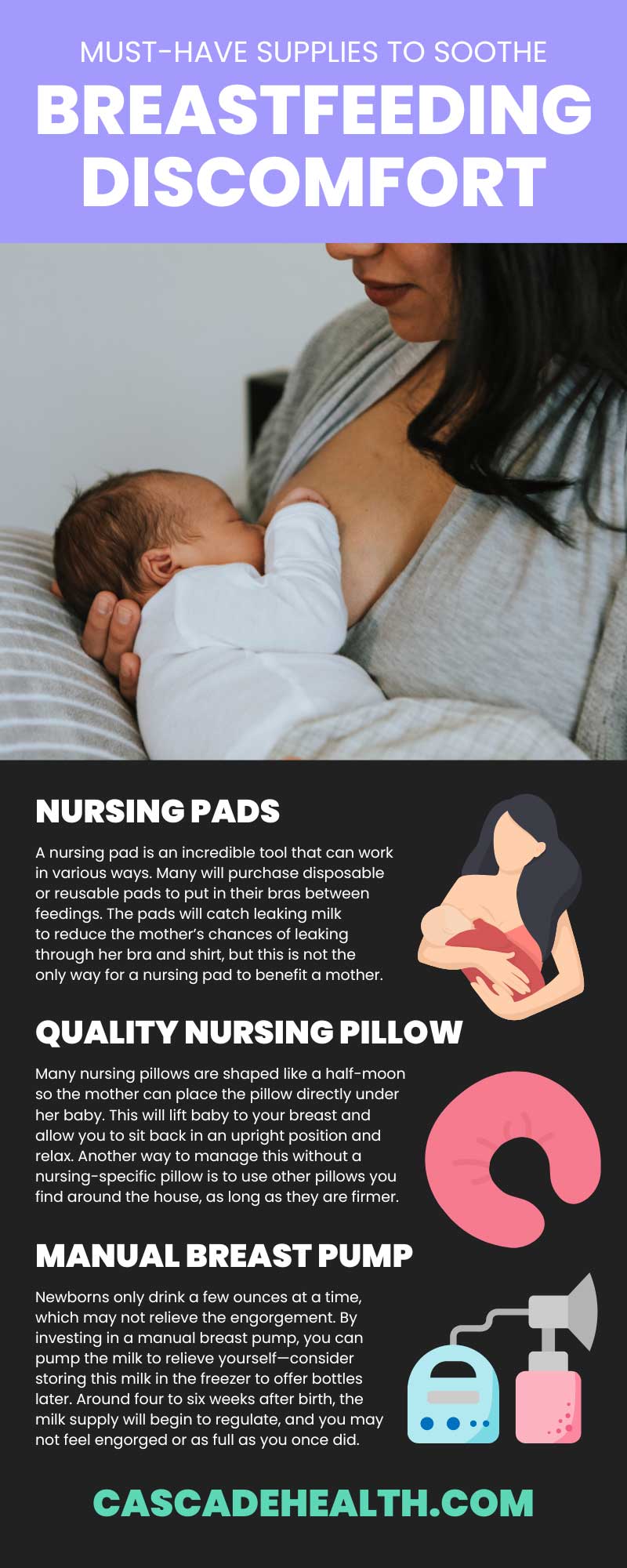Must-Have Supplies To Soothe Breastfeeding Discomfort
For some mothers, there comes a time during the postpartum period when newborn bliss can turn into discomfort and the going gets tough. When that happens, it’s important to not give up; instead, you should lean on your support people for reliable assistance. Additionally, when breastfeeding begins causing discomfort or pain, it’s essential to keep these must-have soothing supplies on hand. Learn more about these handy supplies and discover some solutions for navigating the discomfort.
Common Causes of Breastfeeding Discomfort
Breastfeeding discomfort is an experience that many mothers face, whether their journey is just beginning or they’re several months in. There are a lot of feelings that surround the discomfort as it sets in, and worry is quite common. It’s essential to note that your concerns are valid any time you feel as though your baby’s nutrition supply is in jeopardy. Still, many reliable and healthy techniques are available to bring relief.
Mothers who experience discomfort while nursing commonly develop sore, cracked nipples, pain associated with engorgement, and back or neck pain as they try to find optimal positioning. Regardless of the discomfort source and solution, breastfeeding should be a painless experience without hindrance to the mother’s mental, emotional, and physical states. Explore a few must-have supplies that can soothe discomfort that might occur before, during, or after a breastfeeding session.
Nursing Pads
A nursing pad is an incredible tool that can work in various ways. Many will purchase disposable or reusable pads to put in their bras between feedings. The pads will catch leaking milk to reduce the mother’s chances of leaking through her bra and shirt, but this is not the only way for a nursing pad to benefit a mother.
If you experience tender nipples as you and your baby learn how breastfeeding works best for both of you, consider warming a couple of reusable nursing pads and placing them in your bra to provide relief. The first weeks of nursing sometimes come with slight discomfort as your nipples adjust to the process. In the meantime, you can use the nursing pads as mini heating pads, or freeze them if you prefer a cooling effect.
Nipple Ointments
There are many different nipple ointments and solutions available, and this item reigns supreme in providing direct relief to an affected area. Sore, cracked nipples are common for new mothers during the early days. Learning the best latch requires time and patience, and getting to that place may come with discomfort. There are plenty of creams, balms, ointments, and butters, all with the primary intent of moisturizing and providing relief to sore, cracked nipples.
You can connect with other breastfeeding mothers to inquire about their preferences, or purchase a few options to find the one that works best for you. The optimal time to use an ointment is in between feedings so your nipples can recover before it’s time to nurse again. Mothers commonly experience the most wear when their newborns are cluster feeding; keep your preferred ointment in your diaper changing station so it’s always handy.
Quality Nursing Pillow
A quality nursing pillow will play a critical role in posture management, position, and the mother’s ability to relax during a feed. Without these added external supports, both under the mother’s arms and baby’s body, the mother may experience posture issues and a sore neck. And with enough time nursing, this can dramatically impact her overall physical condition and bring about troubling back pain.
Many nursing pillows are shaped like a half-moon so the mother can place the pillow directly under her baby. This will lift baby to your breast and allow you to sit back in an upright position and relax. Another way to manage this without a nursing-specific pillow is to use other pillows you find around the house, as long as they are firmer.
Manual Breast Pump
There are a few times in a nursing journey where engorgement may come into play. The first instance is when the mother’s milk supply comes in shortly after birth. For the first three to five days, a baby is nursing on colostrum and signaling the breasts to produce mature milk. A mother typically knows when this occurs because her breasts will feel full and possibly harden, making them feel sore.
Newborns only drink a few ounces at a time, which may not relieve the engorgement. By investing in a manual breast pump, you can pump the milk to relieve yourself—consider storing this milk in the freezer to offer bottles later. Around four to six weeks after birth, the milk supply will begin to regulate, and you may not feel engorged or as full as you once did.
Another instance of engorgement typically occurs when the baby first sleeps for long stretches at night. A mother commonly wakes up to one or both sides engorged, sore, or leaking. You may use your manual breast pump to relieve one or both sides until your baby is ready to nurse again.
Milk Collector
A milk collector is a cross between two other common methods. Rather than using a nursing pad to catch leaks or attaching a manual pump to one breast while the baby nurses on the other, a mother might choose to utilize a milk collector. This small, suction-like device can be worn inside the bra to catch leaking milk or letdown on the opposite side.
When a baby is nursing on one side and the other side develops engorgement or discomfort, the milk collector is a great way to quickly drain the other side and capture the milk in a small cup. Many do not want to waste a drop of milk and find that nursing pads don’t allow for retrieval of the leaked milk. The milk collected in the device can be stored in a freezer bag or bottle-fed to your baby later.
Cascade’s Tools and Supplies
Cascade Health Care honors each mother’s preferences and processes. Getting to the bottom of any breastfeeding-associated discomforts and ailments is vital to ensuring a strong, healthy, and confident nursing journey. We offer a wide range of lactation teaching tools and methods to support an array of care providers who help mothers. Partner with us today to learn more about breastfeeding support and teaching tools.

Recent Posts
-
Exploring Recent Innovations in Doppler Signal Processing
Doppler technology has become an essential diagnostic tool in modern medicine, enabling healthcare p
-
Exploring Recent Innovations in Doppler Signal Processing
Doppler technology has become an essential diagnostic tool in modern medicine, enabling healthcare p


